|

by Goro Adachi
November 24, 2002
from
Etemenanki Website
Another Cipher?
On Oct. 22, I received an email message from 'Peter' who decided to
contact me after reading Endgame I and II. He had an insight into
the message encoded in the disk of the 2002 'alien crop glyph',
i.e.:
Beware the bearers of FALSE gifts & their BROKEN PROMISES. Much PAIN
but still time. EELRIJUE. There is GOOD out there. We OPpose
DECEPTION. Conduit CLOSING (BELL SOUND)
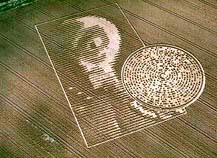
It was the 'damaged word', "EELRIJUE," that Peter found curious:
...if this was created by some group of people, why would they
encode the "damaged word"? I thought about discs and encoding and
suddenly realized that this was the same reason as for encoding
something defective on a CD-ROM or DVD: copy protection. You should
not be able to get the information contained if you don't copy the
"defective" parts.
Then I started looking at the frequency of the individual letters
contained in "EELRIJUE.". I realized by analyzing the frequency of
the individual characters and comparing that to the statistical
frequency of vocals in several languages that whatever was contained
(if it was clear text and not encoded) would be in English or (big
surprise) French [...]
I fired up my trusty anagram generator. The
English anagrams were not very promising, so I tried French and
promptly found the phrase "lieu" [meaning 'place']. Now take the
individual characters and look for their positions: L = 3, I = 5, E
= 1, U = 7. Sorted this gives us: 1 - 3 - 5 - 7.
In other words:
E E
L R I J
U E .
1 2 3 4
5 6 7 8
Peter continued:
Interestingly these are the first four prime numbers but more
interestingly this gives sense to the dot at the end: In
mathematical terminology the dot can be interpreted as a command to
continue the sequence which would lead us to 9 and 11. Remember 9/11
anyone?
Update (11/26): Actually this is not accurate. First, '1' is not
technically a prime number. Second, '9' is not a prime number
either. The numbers 1, 3, 5, 7, 9, 11... are, instead, the first
sequence of odd numbers. And so in that sense, Peter's
interpretation is still potentially meaningful.
Still, I must say I am not quite convinced that this is a valid
cipher. It doesn't seem quite elegant enough. For example, "EELRIJUE"
has three "E"s and thus it does not necessarily have to correspond
to the number 1. And, perhaps more importantly, it has been pointed
out that the damaged word may not be "EELRIJUE" as originally
presented by 'Richard Brain'. There has been a lot of speculations
as to what was actually written there, but so far we have no
definitive solution to this little puzzle.
If Mr. 'Brain' is an 'insider', as I suspect he is, however, the
'mistake' he made in the original decoding may well be a clue in
itself - thus there could still be valuable information contained in
"EELRIJUE." And because of this, I felt Peter's secondary decoding
should not be dismissed quickly.
What made me hesitate to brush aside Peter's insight, additionally,
was the fact that "EELRIJUE," or "lieu"/"place," comes right after
the word "time" in the 'alien' message; 'time' and 'place' are
obviously a coherent coupling. Also, there was a curious
'coincidence' produced by the allusion to prime numbers (and '1', a
quasi-prime number ) in the code (i.e. [1], 3, 5, 7...).
If we
recall, the alien glyph very coherently interacts with the book/film
Contact as explained in Endgame II, and it just happens that in
Contact the very first detection of an alien message is made through
the use of prime numbers encoded in radio waves.

The '9-11' connection Peter pointed out was also curious; as,
obviously, the '9-11' event is a major theme in the 'endgame'
matrix. Notice, for instance, that the modern 'Tower of Babel' (i.e.
the WTC towers) in the modern 'Babylon' (i.e. NYC) nicely parallels
our 'stargate' theme (prominently featured in Contact also) for
'Babylon' means 'gate of the god'.
Furthermore, seeing the relevance of France suggested by the French
word "lieu," Peter wondered if
Nostradamus - a French prophet -
could be somehow entangled in all this.
He wrote:
...when using 9 and 11 to index Nostradamus, this would give us
Century 9, Quatrain 11:
Quatrain 9, 11
Le iuste mort a` tort a` mort l'on viendra mettre
Publiquement du lieu esteint:
Si grande peste en ce
lieu viendra naistre,
Que les iugeans fuyr seront contraints.
Wrongly will they come to put the just one to death,
In public and in the middle extinguished:
So great a
pestilence will come to arise in this place,
That the judges will be forced to flee.
This quatrain contains the word "lieu"... [And also] here you have
some things also contained in "Endgame". The virus (pestilence,
bio-weapons) [...].
The 'plague'/virus association has some deep and very disturbing
implications which will be discussed in Endgame IV. Here, I will
only point out that the devastating epidemic of the Black Death that
killed off a fourth of Europe's population was back in the 1300s,[1]
which may be correlated with '1357', the corresponding numbers for
"lieu" in Peter's cipher.
The 1300s was also when the Knights Templar, the protectors of the
Holy Grail based in France, were outlawed and persecuted. This is
interesting in that the Grail - in conjunction with other sacred
'heavenly stones' - is a major theme we have going with the
'Endgame' and it was interpreted as a 'cosmic virus' in Endgame II.
More remarkably, '1357' was the exact year when the 'Shroud of
Turin' was publicly displayed for the first time on record - and,
again, this was in France (Lirey). The significance of this
additionally is that the Shroud and the Grail are sometimes
considered one and the same. Even on the surface, both relics are
directly associated with the death of Jesus. And, like the Grail,
the Shroud was once possessed by the Templars.
As I wrote in my
Rex Deux article:
Indeed, the Shroud first surfaced soon after the suppression of the
medieval warrior-monks, the Knights Templar, who were accused, among
other things, of worshipping a strange head - which may well have
been the head portion of the Shroud. The first known owner of the
relic, Geoffrey de Charney, is in fact thought to be the nephew of
Geoffroi de Charney, the Templar preceptor of Normandy who was
burned to death with Jacques de Molay, the last Templar Grand
Master.
And some have theorized, with good reason, that the Shroud
was actually created by Leonardo Da Vinci who has been claimed to
have been Grand Master of the
Priory of Sion, supposedly the parent
organization behind the Templar order...
[T]he Templar knights in
the Grail lore are depicted as the guardians of the Holy Grail/Blood
Royal which, in theory (based on "heretical" traditions), stemmed
from the dynastic 'Sacred Marriage' between Jesus and Mary
Magdalene, it may be inferred that the Shroud is in a sense a form
of the Grail which in turn represents the hidden messianic
succession.
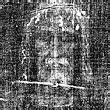
(The head portion of the 'Shroud of Turin')
Shrouded Wisdom
The Turin Shroud is one of the most important and controversial
Christian relics associated with Jesus. It is claimed to be the
linen cloth in which Jesus was supposedly wrapped after the
crucifixion, and imprinted on it is a seemingly photographic image
of "Jesus." Many Christians believe that the image was produced by a
miracle of some kind - Jesus was, after all, is their miracle-making
Messiah.
The Church, however, is not so crazy about the Shroud. Why?
For
starters, the relic has historically been associated more closely
with the 'underground' Gnostic tradition championed by the Templars
and the like. The Church and Gnosticism are - while both stemming
from messianic tradition - bitter enemies and indeed it is not an
exaggeration to state that
the Church
tried to exterminate all
'heretic' Gnostics just as the Nazis tried to eradicate all Jews.
The Shroud, as well as the Grail, revered by the Gnostic
'underground stream' may therefore represent something of a relic
infected with a "virus" for the oppressor, the Church.
There is also the popular theory, supported by carbon-dating, that
the Shroud was actually created around the 1300s, the very period
when the Shroud first surfaced officially. What's more, some have
postulated (see, for in stance, Turin Shroud by Lynn Picknett &
Clive Prince) that it was Leonardo Da Vinci who made the Shroud, and
that the imprinted image is none other than Leonardo himself. And
Leonardo, one of the greatest geniuses in history, was likely more
than a little affiliated with the "heretical" tradition (claimed to
be Grand Master of the Priory of Sion).
It almost seems as if the Shroud, as well as the Grail, is a form of
the 'Trojan Horse' sent into Catholic Christendom, waiting for its
time to shake up the institution from inside by revealing the
explosive truth.
The notions of a virus, hoax/Trojan Horse, the Grail, the fall of
the Church, are all key themes attached to the 'alien' crop glyphs
as discussed in my previous Endgame articles. The implication being
that the Shroud is indeed emerging more and more relevant to the
'endgame' matrix, thus corroborating - accidentally or by design -
Peter's decoding of the 'alien' message.
The next discovery finally solidifies the Shroud's place in all
this.
The design of the 2002 alien glyph, as we recall from
Endgame II,
was most likely borrowed from
the 'Watcher' website, as the
comparison below demonstrates.

It turns out that there is another (original or updated) version of
the graphic in which the 'disk' is replaced by a rotating
tetrahedron. And since the tetrahedron is
 central to the hyperdimensional 'message' of Cydonia/Mars, this has the function of
nicely reinforcing my contention that the alien crop glyph has a lot
to do with Cydonia and hyperdimensional physics. central to the hyperdimensional 'message' of Cydonia/Mars, this has the function of
nicely reinforcing my contention that the alien crop glyph has a lot
to do with Cydonia and hyperdimensional physics.
But more importantly, the 'Watcher' website has this
'alien-tetrahedron' graphic hyperlinked to
a web page that
advertises an encryption program called "InterCypher" (created by
the same guy behind "Ultra-Tech").
And on the page is prominently
featured a screenshot of the 'InterCypher' encryption program, shown
below.
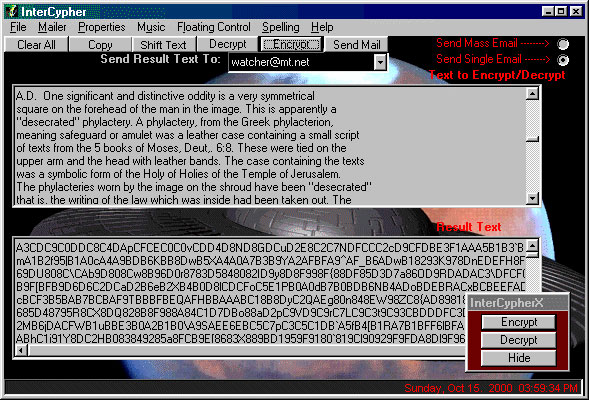
In the two windows are shown the plaintext (i.e. before encryption)
and ciphertext (i.e. after encryption). When I read the plaintext in
the upper window, I was shocked... because it was clearly discussing
the SHROUD OF TURIN!
Consider the implication: this InterCypher program was directly
linked to the alien-tetrahedron logo, a slightly altered version of
the 'Ultra-Tech' graphic which in turn was closely copied by the
2002 alien crop glyph; just as the alien glyph was an encrypted
message, InterCypher produces encrypted messages; and InterCypher's
demonstration image yields the notion that the original message
before encryption deals with the Turin Shroud, or in other words,
that the alien crop glyph, when decoded, would have something to do
with the Shroud!
This is ingenious stuff (whoever is really responsible). And it
doesn't stop here, of course.
As discussed by Ian Wilson in The Shroud of Turin, for example,
there is an suspected alter ego of the Shroud called the
"Mandylion." This relic looks similar to the Shroud and nicely fills
the chronological gap left by the Shroud. And the discovery of the
Mandylion in the 6th century happens to coincide with the emergence
in art of the typical image of Jesus as reflected in the Shroud.
Even if not literally the same relic, it is apparent that the Shroud
and Mandylion are to be associated with each other.
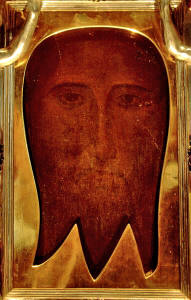
The Mandylion of
Edessa
Interestingly, it is recorded that the Mandylion arrived in
Constantinople on August 15 (944), and August 16 became the relic's
official feast day. This is amazing - if we recall, it was around
August 15 that the 2001/2002 alien glyphs suddenly appeared in a
crop field in England!
At this point, then, the 'signal' has become very strong, insisting
that the 'alien' message somehow has to involve the Turin Shroud.
Indeed, it is no longer important whether or not Peter's decoding of
"EELRIJUE" is valid, as the case for the relevance of the Shroud can
be effectively made independent of it.
Shadow of Baphomet
The new revelations above inevitably imply that the Shroud of Turin
and the issue of Cydonia, prominently emanating from the 'alien
message', are to be integrated.
Some readers may be having a deja vu
right now, because this connection was already alluded to in my
Rex Deux article, written back in March 2002:
...the head imprinted on the Shroud might relate to the more or less
similar-looking 'Face on Mars'. This is clearly a silly notion --
except there are various clues that are supportive of it. This leads
into an area that overlaps my 'other' research that I do not want to
discuss yet. But I'll just mention two curious coincidences: the
Shroud is called sydoine/sindone/sindon in other languages
('Cydonia' anyone?) [...]
This is only a small hint. I don't
want to open Pandora's Box yet... But I will say that Mars/Cydonia
anomalies and the Grail-Ark-Shroud-Fisher King theme are to merge in
a startlingly direct and elegant way.
So I did actually anticipate this new
development facilitated by the alien glyph.
The idea was already
being processed in my "black project," and as stated in the above
excerpt, I was not planning to discuss it in any depth any time
soon. Now, however, the context is such that, as someone who
advocates the importance of truth and the advancement of human
knowledge, I more or less feel obligated to "declassify" some
pertinent findings in this article. (Why use military terminology
like this? Well, it's just fun)
But before getting into that, let us look at the humorous 'Face on
Mars'/'llama on Mars' picture discussed in the first Endgame
article.
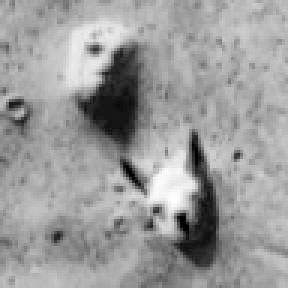
We recall that this picture was implicated in the apparent Odyssey
'conspiracy'/'game' surrounding the Cydonia situation at the present
time.
What I did not bring up previously was the doctored picture's
potential allusion to something called 'Baphomet'.
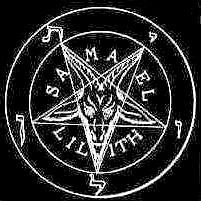
The first time I saw the picture - after I stopped laughing - I
detected a curious, subtly embedded shape. It seemed to me that the
llama's ears and the shadow of the animal's head were together
forming a symmetric and somewhat sinister configuration.
After
wondering for a minute, I came to the realization that the source of
the aura of malevolence was generated by the fact that the shape was
closely resembling that of Baphomet, a "demonic" creature, with a
goat-like head, associated with wisdom.
Baphomet is often envisioned
as the embodiment of the pentagram, and so, naturally, people
usually associated it with 'Satanism'.
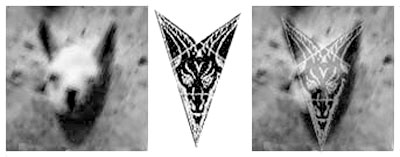
There was a little clue here that suggested to me that this was not
wholly a product of mere coincidence. For instance, the pentagram is
geometrically inseparable from a 'sacred' mathematical value called
phi, also known as the 'Golden Ratio' (1:1.618...), which has also
been found encoded in the 'geometric message' of Cydonia (the
"Rosetta Stone" of which is the 'D&M Pyramid' model, a pentagonal
structure). Finding an allusion to the pentagram in a picture
associated with Cydonia, therefore, made a rather coherent sense.
I did not bring this issue up previously as I felt the correlation
was a little too obscure. Now, however, the Baphomet association
emerges as a more meaningful piece of the puzzle in the evolving
context - because Baphomet is often considered analogous to none
other than the Shroud of Turin!
Like the Shroud, the head of Baphomet is said to have been revered
by the
Knights Templar, as written in Holy Blood, Holy Grail:
Subjected to interrogation by the Inquisition, for example, a number
of knights referred to something called "Baphomet" - too many, and
in too many different places, for Baphomet to be the invention of a
single individual or even a single preceptory... It would appear
that Baphomet was regarded with reverence, a reverence perhaps
tantamount to idolatry... In any case, we found indisputable
evidence for the charge of secret ceremonies involving a head of
some kind.
Indeed, the existence of such a head proved to be one of
the dominant themes running through the Inquisition records... The
head may also be connected with the famous Turin shroud, which seems
to have been in the possession of the Templars between 1204 and
1307, and which, if folded, would have appeared as nothing more than
a head...
[R]ecent speculation has linked the head, at least
tentatively, with the severed head of John the Baptist; and certain
writers have suggested that the Templars were "infected" with the
Johannite or Mandaean heresy, which denounced Jesus as a false
prophet and acknowledged John as the true Messiah.[2]
Note that Baphomet, as well as the
Shroud, seems to exert its
significance specifically as a 'head'. And this reinforces the
coherent 'message' of the 'llama on Mars' picture, since it is the
head of the animal that produces the allusion to Baphomet; and its
position near the 'Face on Mars', also a head, seems to be a subtle
way of telling us that this Martian 'head' is to be regarded as a
form of Baphomet/Shroud as well!
It is worth noting that researchers have noticed a 'severed head'
effect of the Shroud, making the head seemingly detached from the
rest of the body.[3] And it has also been pointed out that the head
of the Shroud is proportionally too small for the body.[4] This
brings to mind the Great Sphinx at Giza, which too has a head too
small for its body, as noted by various researchers.
This potential connection with the Sphinx becomes more meaningful
when we consider the strangely insistent link between the monument
and Mars:
-
The name 'Cairo', the Egyptian capital situated adjacent to Giza,
derives its name from Al Qahira denoting Mars (though more literally
meaning 'the victorious').
-
The ancient Egyptians called Mars 'Horus of the Horizon'
(Horakhti) which was the very same name given to the Great Sphinx.
Mars was also called 'Horus the Red' (Hor Dshr), and for a long time
the Sphinx was painted red.
-
Just as the Great Sphinx is the hybrid of man and a lion, Mars is
Nr-Simha, the 'Man-Lion', in ancient Hindu myths.
-
The term 'pyramid' derives from the Greek
pyr meaning 'fire'
(Mars, the 'fire planet' is often referred to as pyroeis in Greek).
More startlingly, there is the recent discovery/confirmation made by
Richard Hoagland, that the 'Face on Mars' has a Sphinx-like dual
nature - one side representing the head of a lion, and the other
side representing a hominid head.
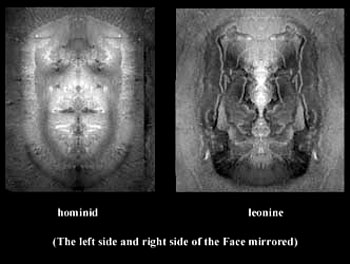
By inference, then, the head of Cydonia may well be a head of
Sydoine, i.e. 'head of the Shroud'.
By extension, it may also be
inferred that the head of Cydonia/Sydoine is a form of the Holy
Grail.
Sangraal, the Holy Blood?
The Grail, an alter ego of the Shroud (and vice versa), contains
numerous layers of symbolism that are not visible on the surface.
The lore of the existence of the sacred relic associated with the
death of Jesus - applicable to both the Grail and the Shroud -
intimates some form of continuation of the Jewish king.
The nature
of the continuation is actually encoded in the original term for the
'Holy Grail', Sangraal, as it can also be translated as 'Blood
Royal'. In other words, as first popularized by Holy Blood Holy
Grail, the Grail/Shroud may actually represent a messianic bloodline
stemming from 'Jesus' (though Jesus himself may well be a
representation of something else).
The bloodline of Jesus?
But he wasn't even married, you might argue.
Of course, Jesus was not sexually active - that is, according to
the
counterfeit messianic tradition promoted by the Church. True, the
Bible does not say anything about Jesus having a son or a wife, but
it is also true that the Bible says nothing to preclude the
possibility either. The subject of Jesus' marital status is
something nonexistent in the Gospels, and this is not necessarily
indicative of Jesus' celibacy.
Granted the cultural background as witnessed… it is highly
improbable that Jesus was not married well before the beginning of
his public ministry. If he had insisted upon celibacy, it would have
created a stir, a reaction which would have left some trace. So, the
lack of mention of Jesus’ marriage in the Gospels is a strong
argument not against but for the hypothesis of marriage, because any
practice or advocacy of voluntary celibacy would in the Jewish
context of the time have been so unnatural as to have attracted much
attention and comment.[5]
But who could possibly have been Jesus' wife?
The likely answer here
is Mary Magdalene – the enigmatic woman who is portrayed in biblical
writings as a close companion of Jesus. She is also the only woman
named in all four Gospels besides the Virgin Mary. One could at
least safely say that if Jesus were indeed married, Mary Magdalene
would most naturally fill the role of his wife. (It has been
suggested that the wedding feast at Cana described in the New
Testament may well be the wedding of Jesus and Mary Magdalene.)
In
fact, unbeknownst to most Christians today, the idea of Jesus having
an intimate relationship with Mary Magdalene is really nothing new
but an idea that was already quite prevalent in the early days of
Christianity.
Obviously, this is not something most Christians want to hear. It is
like telling your child for the first time that Santa Claus is not
real (actually it's exactly that...). After all, the mainstream,
exoteric view of Mary Magdalene promoted by the Church is that she
was a prostitute saved by Jesus. This is largely a misconception,
however.
Even though this portrayal is accepted virtually as a
'fact' today, it is in reality merely an "official" interpretation;
the New Testament actually never states that she was a prostitute.
Besides, the term 'prostitute', as hierodulae, would refer to the
'sacred women' of the temple of the Goddess who performed a ritual
practice resembling the anointing of Jesus by Mary of Bethany (often
equated with Mary Magdalene) described in the Gospels.[6] And
tellingly, in ancient times, anointing of the king was a ritual –
called the 'Sacred Marriage' in Greek – performed by a royal
bride.[7]
What's more, the strong parallel often noted between Jesus and
Osiris, the ancient Egyptian god of the dead, reinforces this idea
of Jesus and the Magdalene being in a intimate relationship, because Osiris' wife, Isis, is considered identifiable with Mary Magdalene.
According to mythology, Osiris was murdered by his brother Seth, and
was then miraculously brought back to life by Isis (still childless
at the time) so that she could receive Osiris' seed and give birth
to Horus. Applying this element to Jesus' death and resurrection, it
becomes very natural to have Mary Magdalene playing the role of
Isis. Indeed, the Magdalene is not only a prominent figure in the
episodes of the Crucifixion and the subsequent resurrection, she is
even recorded as the very first one to witness the resurrected
Jesus![8] This, therefore, strongly suggests that
Mary Magdalene,
following in the footsteps of Isis, was impregnated by
Jesus around
the time of the Crucifixion.
We see here a potential motivation behind the Church's paranoid
hostility towards the Gnostics and the Magdalene (or womankind in
general). It may well be linked to the threat the 'Blood Royal',
i.e. descendants of Jesus, would pose for the authority of the
Church.
This is because for the Church to wield power over the
masses, Jesus needs to be as divine as possible and gone from the
earthly realm so that it can position itself between the people and
the divine whereby it becomes possible for the Church to pretend to
speak for the heavenly authority. The mere existence of Jesus'
descendants would greatly undermine this illusory ecclesiastical
power.
The Church, as its history clearly shows, wants power more
than it does the truth. And so it has apparently done its best to
keep the existence of the 'Blood Royal' secret from the general
public through, for example, the notorious Inquisition. (How ironic
is it that those claiming to be the worshippers of Jesus probably
are in reality Jesus' worst nightmare?)
Now, I must qualify the above discussion by stating that it is
likely only one level of meaning encoded in the biblical tradition.
It may still be a coded story itself. And, quite frankly, we should
not even presume the literal existence of an messianic individual
called Jesus as described in the Bible. Chances are, 'Jesus' himself
is a composite character containing aspects of various historical
figures.
(Ancient Egyptian kingship is actually a big piece of
puzzle in this, but we won't go into that here.)
Beauty and the Beast
Here is where I need to disclose some of my "black project" findings
- meaning there will be some profound implications. This will reveal
what I meant when I wrote,
Mars/Cydonia anomalies and the
Grail-Ark-Shroud-Fisher King theme are to merge in a startlingly
direct and elegant way," back in March.
First, note that both Jesus and Mars are associated with Horus, the
son of Osiris and Isis. (The Red Planet was called 'Horus the Red'
in ancient Egypt.) Horus being the embodiment of the 'Blood Royal'
(stemming from the union of Osiris/Jesus and Isis/Magdalene), this
lets Mars analogous to the Grail. The Jesus-Horus equation, on the
other hand, seems paradoxical since Jesus has already been compared
to Osiris, Horus' father.
However, this is not necessarily
incongruent if we view 'Jesus' as representing the bloodline itself.
Even in ancient Egypt, the distinction between Horus and Osiris was
not so clear-cut - and so the pharaoh, the living Horus, was
considered to become Osiris upon death, and such. Indeed, according
to the foregoing scenario, the birth of Jesus' child coincides with
the death of Jesus as if to paint a more resurrection/rebirth type
transition.
The same kind of overlap is observed for Mary Magdalene and the
Virgin Mary (Jesus' mother) also. Both, for instance, are considered
analogous to Isis. The perceived prostitute and the virgin, while
seemingly at the opposite ends of the spectrum, are actually two
sides of the same coin. As writer Ean Begg has expressed, 'the
Ark/Grail is the symbol of the virgin, whore, wisdom…',[9] and Isis
was correspondingly a harlot and a virgin at the same time.
Apparently, the Virgin Mary was also sometimes used as a 'coded'
reference to Mary Magdalene, the latter being a controversial figure
for the Church.[10]
The basic implication pertinent here is that Mars-Horus is connected
with the Grail tradition involving Jesus and Mary. What solidifies
this notion is the fact that, according to Greek tradition, the
sphinx - an alter ego of Horus/Mars - was a mixture of Leo's body
and Virgo's head;[11] or to use another terminology, the Sphinx is a
combination of Horus and Isis, or Jesus and the Virgin!
Complementarily, it just happens that Leo and Sirius/Venus, the star
of Isis-Mary, were both associated with Virgo in ancient tradition,
and the early Arabs even visualized a huge lion in the constellation
of Virgo.[12]
Note that Jesus himself, like Horus, is clearly a
leonine figure in that he was a direct royal descendant of King
David, the 'lion king' (the Davidic tribal symbol was the lion).
The Sphinx and Mars, therefore, represent the sacred union of Jesus
and Mary, or Osiris and Isis. In other words, the Sphinx/Mars is the
Grail, the Blood Royal, and the Shroud. Furthermore, in light of our
foregoing discussion, the Martian counterpart of the Shroud, i.e.
the 'Face on Mars', would become a monumental embodiment of the
Jesus-Mary union.
The leonine element found in the Face is already in accordance with
the 'lion king' aspect (i.e. Jesus-Horus) of the Grail union; and
the pentagram/Baphomet already associated with the Face resonates
with the Mary aspect as the pentagram is traditionally associated
with the Isis-Magdalene-Venus complex. But here is a new discovery
revealed for the first time anywhere. This will begin the process of
bringing the whole field of Cydonia investigation into a new
dimension, and I think a lot of the researchers will not be able to
keep up with the shift and will soon find themselves 'out of the
game'.
It turns out that in the 'Face on Mars' is clearly encoded the
sacred unification of Sangraal - even more directly than the Sphinx!
The process of this particular discovery began in the spring of 2001
when NASA released a new picture of the 'Face on Mars' taken by
Mars
Global Surveyor. The first reaction, for the most part, was one of
disappointment – the image of the 'Face', the clearest one to date,
showed a rock formation only slightly resembling a hominid head.
After reading Richard Hoagland's analysis on on the image, however,
I was compelled to agree with his view that the monument is half-man
and half-lion. I found this exciting, and decided to show the
mirrored images to my brother, expecting him to see the same
depictions. Instead, he saw something quite different.
Let me quote from my second book (a work in progress):
[E]ven to him the lion head was clearly visible. But when I showed
him the mirrored hominid face, his response was certainly not what I
had expected. To him, it was a depiction of, not a head, but a human
torso.
"You see what?" I reacted with puzzlement. "It is a body," he
repeated, "of a human with arms, and it's missing its head and
legs."
In confusion, I took another look at the image – and indeed,
there it was, a human torso. It was rendered with apparent nipples,
a navel, and hands clasped at the genital area. What caught my
attention next were the seemingly accentuated breasts and the
swollen belly.
I inevitably wondered:
"Is this a depiction of a
pregnant woman?"
Then it hit me. This was the body of Virgo, the Virgin, and it was
pregnant with Horus-Jesus! Indeed, just as is the torso image, Virgo
traditionally "is a headless constellation, the stars marking the
head being very faint."[13] [...]
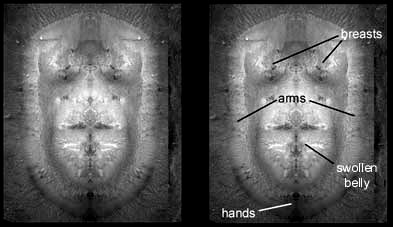
In other words, the 'Face on Mars' produces a lion head and the
pregnant body of Virgo - i.e. the mirror image of the Sphinx, which
traditionally has Virgo's head
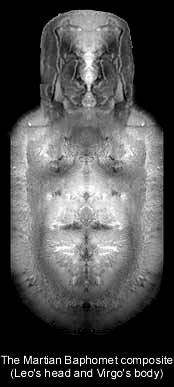 and Leo's body! (It must also be
recalled that the cosine of the Giza latitude equals the tangent of
the Cydonia structures' latitude – both equaling e/pi.) and Leo's body! (It must also be
recalled that the cosine of the Giza latitude equals the tangent of
the Cydonia structures' latitude – both equaling e/pi.)
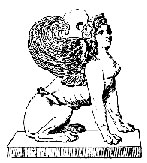 The fact that
Baphomet - i.e. the Shroud, and by extension the Face
- is said to be androgynous also meshes perfectly with this
Leo-Virgo fusion. The fact that
Baphomet - i.e. the Shroud, and by extension the Face
- is said to be androgynous also meshes perfectly with this
Leo-Virgo fusion.
And this brings up another issue: the Virgin element for the Shroud.
The Grail, Face, Sphinx, and Baphomet are all expressions of the
fusion of Jesus-Osiris and Mary-Isis, or God and Goddess. The Shroud
clearly being another manifestation of the same concept, as we have
seen, it has to be inferred that the imprinted image of 'Jesus'
should include a reference to the female counterpart as well.
Surprisingly, it appears that this is indeed the case.
First, we see that the hand position of the Shroud person, covering
the genital area, echoes the apparent configuration of the 'Virgin'
depiction in Cydonia. And aside from this sex-hiding act, we notice
that the body of the Shroud person is actually quite feminine.
No
one seems to have caught this before, but without the awkwardly
placed head, the first impression people would get is that this
might be a woman's body - with delicate hands, a seemingly wide hip,
and accentuated breasts!
The startling implication here is that the Shroud image seems to be
a composite of a female body and a male head - just like the Martian
Face/Shroud! As if this weren't enough, we also have the theory
presented in Picknett and Prince's Turin Shroud that the Shroud head
is actually that of Leonardo Da Vinci.
Note that with the name
"Leo-nardo," it may be said that the Shroud person has "Leo's head"
- just as does the Martian Shroud.
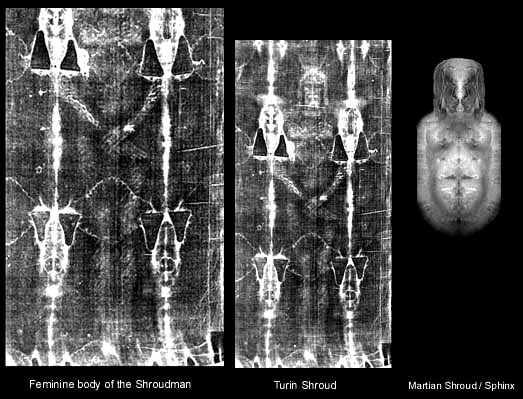
Adding more support to the idea is the fact that Leonardo, sometimes
viewed as the 'Keeper of the Grail', has a special connection with
John the Baptist, the forerunner of Jesus, who was decapitated (thus
the 'detached head' link).
The Leonardo-John association is
addressed by Picknett/Prince:
The only surviving sculpture that involved Leonardo in its making is
the statue of John the Baptist in the Baptistry in Florence... And
Leonardo's last painting was 'John the Baptist', showing him with
the same half-smile as 'The Mona Lisa' [by Leonardo], and pointing
straight upwards with the index finger of his right hand.
This in
Leonardo's work is a sign always associated with John: in the
'Adoration of the Magi' a person stands by the elevated roots of a
carob tree - John's tree, symbol of sacred blood - while making this
gesture. In his famous cartoon of St Anne the subject also does
this, warning an oblivious Virgin.
Make of it what you will that the
disciple whose face is perhaps accusingly close to Jesus' in 'The
Last Supper' [also by Leonardo] is also making this gesture. All
these gestures are saying 'remember John'.[14]
'Coincidentally', the Shroud is today kept at Turin's Cathedral of
St. John the Baptist.
Enter the Antichrist
So, why John the Baptist? What's so special about him?
As it turns out, John, along with Mary Magdalene, was revered by
most Gnostics, sometimes as the 'true' Messiah who was usurped by
Jesus. Conversely, the Church has done its best to marginalize both
John and the Magdalene all through its history. Picknett/Prince, in
The Templar Revelation, even point out that Jesus and John were
likely bitter enemies/rivals.
John the Baptist, then, can be perceived as anti-Jesus... err... the
'Anti-Christ'?
Frankly, I have this tradition on this website of not discussing the
'Antichrist' per se - as the whole concept is too 'Christianized'
for me - but I guess it is now unavoidable to include it in our
discussion. It is worth noting that the 'Watcher' website, a key
piece of the 'endgame puzzle' initiated by the 'alien' crop glyph,
is all about Cydonia/Mars and how it relates to the coming
Antichrist.
It therefore seems the issue is indeed pertinent here.
But, of course, my position on this will not be the typical,
Christian approach of blaming everything evil on the Antichrist.
John the Baptist, as well as the Magdalene, essentially represents
the oppressed truth. When the societal system is dependent on the
suppression of some truth, this creates a building pressure in the
'matrix' of reality, which increasingly becomes a "threat" to the
oblivious world. The longer the truth is suppressed and the more
dependent the society becomes on the negligence, the more dangerous
the situation gets - as the truth becomes a ticking 'time-bomb'
waiting for the time of Revelation. The 'side-effect' of this will
be the 'Apocalypse'.
This 'suppressed truth', in the context of our Endgame discussion,
would be Cydonia (extraterrestrial intelligence), hyperdimensional
reality/technology, and Gnosticism (personified by John the Baptist
and Mary Magdalene).
It is easy to see how the revelations about Cydonia artificiality and
hyperdimensional reality (i.e. the 'other
side') would severely upset the world economy and religious
theology. But what is represented by the Gnostic
John-Mary-Shroud-Grail complex is more shadowy and harder to
penetrate - because the history of its suppression is so extensive
and convoluted.
The western Christian world is so ignorant of the true nature and
origin of their religion that it would be funny if it weren't so
tragic. A case in point: just recently there was a major news story
about the discovery of what may be a burial box of James the Just,
Jesus' brother, in Israel. Of course, for many Christians the
reaction was, "you mean, Jesus had a brother?"
Then, in response to
the report that this finding, if valid, would be the first
historical evidence for the existence of Jesus outside of the Bible,
many Christians must have found themselves struggling to fathom the
implication that the mere existence of their object of worship had
been uncertain at best. In other words, most Christians (though
probably also applicable to other religions) don't know, or care
about, the very basics of what they claim to worship.
And this stems
from the doctrine and of the Church, which is really about promoting
its version of the messianic tradition reconstructed and twisted
around to suit its political agenda. It's simply not in the interest
of the Church to teach its followers the history of the religion in
any depth, otherwise the worshippers might get curious and find out
all the manipulations on which the authority of the religious
institution is based.
In any case, it is certainly coherent that the fall of the Church,
an aspect of the larger theme of 'Babylon falling', is an integral
part of the 'endgame' as discussed in my previous articles. When the
'truth time-bomb' ticks down to zero, the Gnostic/suppressed side of
religious history embodied by John/Mary comes out of the ground to
cause great havoc. And this may be viewed as the apocalyptic time of
the "Antichrist" who is prophesied to come just before the return of
Christ. And most fittingly, the Gospels tell us that it was John the
Baptist who came right before Jesus to pave the way.
As all the 'signs' are now suggesting, it is time for truth to rise
up. And truth often hurts. Denial or truth - which will mankind
choose?
Golden Message
Going back to the 'alien sign', I detected another potential message
subtly encoded in its deceivingly superficial design. It was the
notion of pentagram now attached to the crop glyph that enabled me
to see an allusion to phi (the 'Golden Ratio'), a value inseparable
from pentagonal and Cydonia geometry.
In mathematics, phi is represented by a symbol, a circle bisected by
a vertical line.
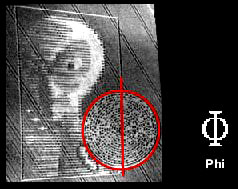
As it turns out, this is exactly what we see in the glyph - a circle
(the disk) bisected by a vertical line of the rectangular frame!
That this is no coincidence is effectively demonstrated by the fact
that one of the phi numbers, 0.618, multiplied by the number of days
in a year (365), gives us 225 (days). This is the precise duration
of Venus' orbit around the sun (225 days), and Venus is
traditionally denoted by the pentagram. What's more, counting 225
days from January 1st brings us to around August 15, i.e. the very
date of the appearance of the 'alien' crop glyphs!
August 15 also
happens to be the Feast of the Assumption of the Virgin Mary,
followed a day later by the feast day of the Mandylion, an alter ego
of the Shroud!
What enhances the significance of the involvement of phi in the
'alien message' even more is phi's connection with a geometric
configuration known as vesica piscis, which is composed of two
overlapping equal circles (the centers of each positioned on the
circumference of the other circle).
This formation is revered since
ancient times and belongs to the realm of 'sacred geometry' - due at
least in part to its ability to generate phi.
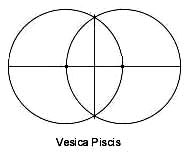
Traditionally, vesica piscis signifies, as does the
pentagram/Baphomet in some respect, the unification of heaven and
earth. It is, to use different terminology, a 'stargate' symbol.
Needless to say, this is directly relatable to the same theme
derived previously from the 'alien' glyph, i.e. hyperdimensional
physics, which is also theorized to be the ultimate 'message of
Cydonia'.
Remarkably, we find that vesica piscis is also long considered to
represent Jesus Christ - just as we found the 'alien' crop message
to contain a coded reference to the messianic tradition (i.e. the
Grail/Shroud).
At this point, I became quite convinced that geometry was a big part
of the 'alien' message, and so I went on to examine the design of
the glyph for any further allusions to sacred geometry. Naturally,
my first instinct was to check the ratio of the length and width of
the rectangular frame encasing the 'alien'.
First, I had to get the measurements of the rectangle, and the most
specific numbers I managed to find on the net were 250 ft and 360 ft
(likely still approximate). From these, I calculated that the
width-length ratio would be about 1:1.4. This was intriguing because
~1.4 was probably a reference to sqrt 2 (= 1.4142...), another
'sacred' numerical value associated with vesica piscis.
This then led to the next important revelation.
ET IN ARCADIA EGO...
It was one of those flashes of intuitive insight. I just had this
urge to check if the alien-glyph rectangle could correspond to the
dimensions of a certain painting in terms of proportion.
The
painting I had in mind was The Shepherds of Arcadia II (Les Bergers
d'Arcadie II), also known as Et in Arcadia Ego II, by the celebrated
neo-classical painter from the 17th century, Nicholas Poussin.
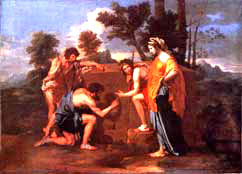
As those familiar with the
Rennes-le-Chateau mystery in southern
France (yes, France again) - popularized by Holy Blood, Holy Grail
in the 1980s - would undoubtedly know, The Shepherds of Arcadia is a
major piece of the 'Grail puzzle'.
There is strong evidence that Poussin encoded hidden messages in the painting that concern secret
Gnostic knowledge - knowledge about the great mystery embodied by
the 'Grail' or 'Ark' (essentially interchangeable). This is already
hinted at by the enigmatic phrase (carved on the tomb in the
painting), 'ET IN ARCADIA EGO', literally meaning 'And in Arcadia
I'.
Viewed as an anagram for Arca Dei, the term 'Arcadia' would mean
'Ark of God', i.e. the Ark of the Covenant,[15] and so by extension
the Grail.
The pertinence of the painting to our discussion is also strongly
suggested by the fact that the underlying geometry of this
masterpiece of Poussin is pentagonal. As Professor Christopher Cornford of the
Royal College of Art told Henry Lincoln:
"If Poussin
is saying anything… he seems to be saying that pentagons and
pentagrams and their constituent angles are very much involved."[16]
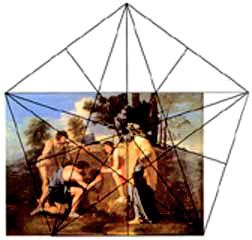
Furthermore, notice that the mysterious shepherdess in the painting
looks as if she could be pregnant (which would make the number of
persons in the painting five, the very number emphasized by the
pentagonal geometry).
Assuming that the tomb is that of Jesus (and
there is much to support this idea, though I won't going into it
here), it could be easily inferred that the woman is none other than
Mary Magdalene pregnant with dead Jesus' child, just as Isis's
pregnancy took place in conjunction with the death of her husband, Osiris. The fact that the center of the embedded pentagram pinpoints
the head of the shepherdess reinforces this interpretation - as
pentagram traditionally symbolizes the Magdalene-Venus-Isis complex.
And it is important to point out that, according to legend, Mary
Magdalene did go to southern France sometime after Jesus'
crucifixion; the scene depicted in the painting is thought to be
southern France, near Rennes-le-Chateau.
Indications, then, are clearly that there is a good chance the
painting does interact with the 'alien' crop glyph.
As I checked the dimensions of The Shepherds of Arcadia, I was both
surprised and not surprised. My intuition was valid. The
height-width ratio of the painting was practically identical
(1:~1.4)to that of the box enclosing the 'alien'!
There is actually much more here - we have only scratched the
surface - but I feel I should stop at this point... for now. All
this is quite a lot to digest - I'm sure this is the first time that
all the different subject matters, especially Cydonia and the
underground Gnostic tradition, have been put together and viewed as
aspects of the same 'game'. Strange stuff, yes, but this is where
the 'game' is going, so people should get used to it.
I'll leave you with another 'sign' I found in The Shepherds of
Arcadia.
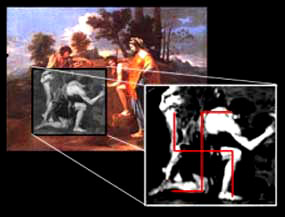
This foreshadows what will be revealed in Endgame IV... Very dark
things.
Large black clouds are looming ahead of us.
Wrongly will they come to put the just one to death,
In public and in the middle extinguished:
So great a pestilence will come to arise in this place,
That the judges will be forced to flee.
References
[1] Lyn Picknett and Clive Prince, Turin Shroud (New York:
HarperCollins, 1994), p.23
[2] Michael Baigent, Richard Leigh, and Henry Lincoln, Holy Blood,
Holy Grail, pp.82-3
[3] Picknett and Prince, Turin Shroud, pp.132-5; Ian Wilson, The
Shroud of Turin (Garden City, New York: Doubleday & Company, Inc,
1978), p.9
[4] Turin Shroud, pp.66, 138.
[5] Charles Davis, in The Observer (London: March28, 1971), cited in
Holy Blood, Holy Grail, p.331, see also Geza Vermes, Jesus the Jew
(Philadelphia: Fortress Press, 1973), p.99ff.
[6] Margaret Starbird, The Woman with the Alabaster Jar (Santa Fe,
New Mexico: Bear & Company, 1993), p.29.
[7] ibid. pp30, 36.
[8] John 20:11-18.
[9] Ean Begg, The Cult of the Black Virgin (New York: Arkana, 1985),
p.52
[10] Picknett and Prince,
The Templar Revelation, p.113.
[11] Allen, Richard Hinckley, Star Names: Their Lore and Meaning
(New York: Dover Publications, 1963), p.465.
[12] Ibid., pp.462-5.
[13] Ibid., p.462.
[14] Turin Shroud, p.180.
[15] Richard Andrews and Paul Schellenberger, The Tomb of God (New
York: Little, Brown & Company, 1996), p.107.
[16] Lincoln, Henry, The Holy Place (New York: Arcade Publishing,
1991), pp.63-4; Lincoln, Henry, Key to the Sacred Pattern (New York:
St. Martin’s Press, 1998), pp.109-10.
|





 central to the hyperdimensional 'message' of Cydonia/Mars, this has the function of
nicely reinforcing my contention that the alien crop glyph has a lot
to do with Cydonia and hyperdimensional physics.
central to the hyperdimensional 'message' of Cydonia/Mars, this has the function of
nicely reinforcing my contention that the alien crop glyph has a lot
to do with Cydonia and hyperdimensional physics.






 and Leo's body! (It must also be
recalled that the cosine of the Giza latitude equals the tangent of
the Cydonia structures' latitude – both equaling e/pi.)
and Leo's body! (It must also be
recalled that the cosine of the Giza latitude equals the tangent of
the Cydonia structures' latitude – both equaling e/pi.) The fact that
Baphomet - i.e. the Shroud, and by extension the Face
- is said to be androgynous also meshes perfectly with this
Leo-Virgo fusion.
The fact that
Baphomet - i.e. the Shroud, and by extension the Face
- is said to be androgynous also meshes perfectly with this
Leo-Virgo fusion.




